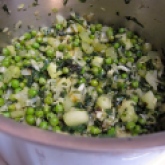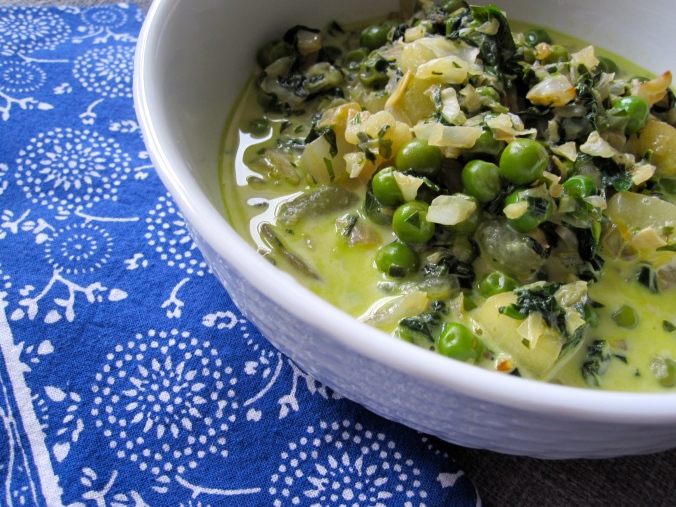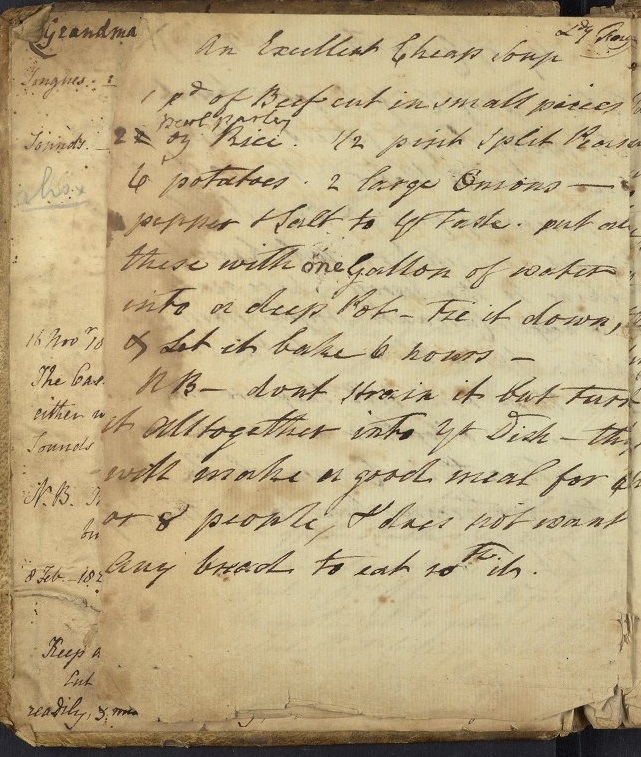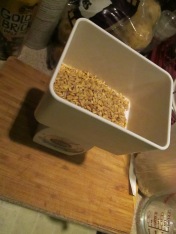soup
Herb Soop
A few weeks ago, thanks to my old friend George Leader, I was lucky enough to visit an archaeological dig at an eighteenth-century farmhouse on The College of New Jersey’s campus. I’d never been to a dig site before, so the technical details alone were fascinating: the reasoning behind determining where to dig in the first place, the standing sieve to strain buckets of earth for artifacts, the practice of wrapping fragile artifacts in foil (who knew!), the technology used to date wooden architectural features. I really dug it. (Sorry. Couldn’t resist.)
Seeing the farmhouse, getting to hold some of the artifacts unearthed that day – a metal button, a shard of blue and white pottery, and a small clay sphere that we theorized might have been a marble – made me think about this project and what we can uncover. I’m used to engaging with the past through words on a page. The archives always feel a little bit magical to me: these texts still exist centuries later, and I get to touch them, smell them, read them. I felt a similar tug at the dig, seeing artifacts being unearthed and thinking about our access to the past through what happens to have been left behind. At a basic level, archaeological investigation and archival literary research give us physical access to fragments of past lives, preserved deliberately or accidentally. You figure out where to look, but you don’t always know what you’re going to find.
This project is one of reconstruction from a distance and with pieces missing: the recipes are vestiges of what did get recorded, leaving little behind of what didn’t. Cooking from the archives creates a powerful bridge between me and the past. I will never stand in a kitchen without refrigeration, without even the possibility of electric lights, without having spent my whole baking life reaching automatically for ingredients like vanilla extract and uniform sticks of butter, but I can still approximate how Naples biscuits would have tasted nearly three hundred years ago.
There’s always a gap, though, related to how just far that bridge can reach. Working on this project has brought me up short at this gap time and again: reading handwritten manuscripts begs to know more about the person who wrote them, but there’s often little headway to be made. We can decipher handwriting, but identities are harder. This impulse isn’t just personal – it’s a question that comes up often for me and Marissa, of who wrote these recipes down, of what we know about them. Usually, not much. But this recipe left a faint trace of one of the individuals behind it.
This Herb Soop comes from UPenn MS Codex 1038, home to some of my favorites, like the Maccarony Cheese and Desart Cakes. The volume contains at least three separate hands, and we still don’t know anything about these writers. This handwriting is the second in the volume, probably written down sometime in the 1790s or early 1800s. The end of the recipe attributes it to “Lady Laroche.” (She is probably the source and not the writer of this recipe, since several subsequent recipes in the same handwriting are attributed to other women.) It is nearly impossible to know anything about the other women whose names accompany their recipes – the Mrs. Baker who gave the writer her recipe for Curd Cheescakes, the Mrs. Fordham who told her how “To make Flumery,” or the Mrs. Turner who showed how “To Dress a real Turtle as the[y] do in the West Indies,” for instance. “Lady,” however, provides direction in a way that “Mrs.” often cannot.
It turns out that this “Lady Laroche” can be one of only two women. James Laroche, a Bristol politician and slave-trader, was created baronet in August 1776. Since the baronetcy became extinct when he died in 1804 without any male heirs, this Lady Laroche has to have been one of his two wives. The first Lady Laroche was born Elizabeth-Rachel-Anne Yeamans in Antigua. An heiress (she brought at least one plantation to the marriage) and widow, she married James Laroche in 1764 and moved to England with him. After Elizabeth-Rachel-Anne died in 1781, James remarried; his second wife may also have been named Elizabeth. We know nothing else of her except that she survived her husband and died in Wales in 1824. Can we know how or even if this recipe writer and either Lady Laroche knew each other? What else they might have talked about, why this particular recipe was the one shared? No. But sometimes, even this small glimpse into archival identities feels like uncovering something satisfying.
The Recipe
To make Herb Soop
Take Parsley, Spinnach, Cabbage Lettice, Leaves of
White Beet, Sorrell, Cucumbers, Pease & small Onions
with the green ends to them, a little Mint, and a very
little Fennell. Wash them all clean, and Chop the
Herbs very small. Season them with Pepper & Salt,
Put them into a Pot to stew with a piece of Butter
according to your quantity, but no Water. Let
them stew quite tender. Have ready boiled some
Cream or Milk, with the Yolks of Eggs beat up in it,
Mix this gently with the Herbs and serve it up.
You must not let it boil, or be on the Fire after the
Eggs are put to it. You are to observe it is not to
be a thin liquid, but more herbs than Soop. that is,
thick of the Herbs. Less than half a pound of butter
will do unless the Terene is very large. There shoud
be Cellery chopped amongs the herbs if to be had &
—-
other herbs you like but not strong of any one in particular.
Some leave out the Fennell, as it is apt to be too strong.
Lady Laroche.
Our Recipe
3 generous handfuls of spinach (about 1 1/2 c. chopped)
1/2 c. parsley, chopped
a few mint leaves, chopped
1 large or 2 small cucumbers, diced (I also seeded mine)
1-2 celery stalks, sliced thinly
1 c. chopped cabbage
3/4 c. green peas (fresh or frozen)
3 scallions, sliced thinly
1/2 tsp. salt
a few grinds of pepper
1 tbsp. butter
1/2 c. milk
1 egg yolk
In a medium saucepan, combine all ingredients except for the milk and egg yolk. Cook them over low-medium heat, stirring often enough to prevent the greens from sticking. Cook until the greens are all wilted and the cucumbers are translucent; for me, this took about 20 minutes. (Though you could probably let them “stew” even longer.) Heat the milk in the microwave or on the stove until quite hot. In a small bowl, whisk the egg and then, still whisking, add the hot milk in a steady stream. Remove the herb mixture from the heat and stir in the milk. Serve immediately.
The Results
The Soop tasted green: stewed together, the herbs and vegetables made a pleasantly flavorful whole. I’d never had cooked cucumbers before and was curious – they softened but held their shape, rather like zucchini, and provided nice texture in the soup. I liked the zip from the scallions and the chewiness of the cabbage (even if cooking it did make my kitchen rather … fragrant). In its piling together of many different herbs and vegetables, the Herb Soop felt like a precursor to some of Yotam Ottolenghi’s recipes. I found it satisfying that what I was tasting was probably pretty close to some of the results this recipe would have yielded for eighteenth-century cooks: all of the ingredients remain available, the cooking technique was easily duplicated in my kitchen (albeit with the ease of a gas stove), and the methodology was specific enough that I could follow the recipe’s instructions closely.
In fact, this Herb Soop recipe is quite detailed in its ingredient list and instructions – it’s very helpful to know, for instance, that the end result should be “more herbs than Soop” – more so than many of the other recipes we’ve engaged with, like Artificial Potatoes. But it provides few precise measurements. I guessed at these proportions, determining them largely based on what I had and what I liked. (I don’t love fennel, so I’m one of those “some” the recipe mentions who “leave [it] out.” And my little produce market doesn’t carry sorrel, so I didn’t use it.) And I imagine that’s what early cooks did as well, making the soup slightly differently each time based on what needed to be used or what was available.
What else could you toss in here? Leeks, zucchini, basil, cilantro, green bell peppers – really, anything green that happens to be lurking in your crisper could make its way into this soup. Some hot pepper flakes would liven things up. I see the appeal behind the milk-and-egg liquid choice: it’s a rich addition and adds some depth to the greens. However, I might substitute some vegetable broth or chicken stock for a lighter soup. Basically, this recipe provides a wonderful alternative idea for using up the leftover greens that I normally toss into a grain salad, a stir-fry, or baked eggs.
An Excellent Cheap Soupe
It’s soup season. I live in southern California and I have absolutely no complaints about winter weather, but I did get a good dose of cold when I visited Alyssa in Philadelphia this month to work on project planning and to prepare for our forthcoming profile in frankie magazine (out April 2015). In any case, who doesn’t enjoy a good bowl of soup?
This recipe comes from Ms. Codex 644. Penn’s catalogers suggest that the manuscript was compiled between 1750 and 1825 and attribute this book primarily to a Lady Frankland with some additions in other hands. A note inside the front cover the manuscript entitles the volume “Grandmama Lady Frankland’s Receipt Book.”
This manuscript may be a product of the household of Sir Thomas Frankland, fifth baronet (1718–1784). This is a preliminary speculation, but one I hope to research in more detail. I’ve linked to wikipedia above because it’s freely accessible, but I’m also drawing on information from the Oxford Dictionary of National Biography.
Sir Thomas Frankland married Sarah Rhett of South Carolina (1724-1808) in 1743 and she may very well be the “Grandmama Frankland” who compiled and used this recipe book. The family likely lived at the Frankland estate in Mattersey, Nottinghamshire while Frankland traveled between England and the West Indies where he was involved in the Atlantic slave trade, among other commercial ventures. The couple had many children (somewhere between thirteen and nineteen according to various accounts), and nine lived long enough to be mentioned in Frankland’s will. This recipe for cheap soup would certainly feed a crowd.
If this volume truly is a product of the Frankland family, my preliminary biographical research leaves me with many questions about the volume: What kind of history can these recipes possibly reveal? Can the volume provide a window into the history of slavery? Does it have anything to tell us about southern foodways, transatlantic communication, and global recipe exchange? For example, Frankland was born in the East Indies, possibly in India, and that connection to South Asia may explain the presence of a recipe for Indian Curry in the volume.
Stay tuned for more on Ms. Codex 644 as we continue to research its provenance and try out its intriguing recipes!
The Recipe
Lady Fagg
An Excellent Cheap Soupe
1 pound of Beef cut in small pieces
perl p[b?]arley
2 2 oz Rice. 1/2 pint split Peas
6 potatoes. 2 large Onions —
pepper & salt to the taste. put al[l]
these with one Gallon of water
into a deep Pot – Tie it down,
& Let it bake 6 hours –
NB – dont strain it but turn
it alltogether into the Dish – th[is]
will make a good meal for 6
or 8 people, & does not want
any bread to eat with it.
This is a straightforward recipe and it required minimal modification to work in my kitchen.
The soup recipe, like many others in the volume, is attributed to Lady Fagg in a small note at the top right corner of the page. Other sources noted in the manuscript include – Lady Monson, Lady Roche, Miss Colville, Miss Bedingfeld, Miss Bowles, Richard Jebb, Mrs. Cowslade, Baroness Philetsen, Dr. Addington, Dr. Bateman, Dr. Reynolds, and Dr. Darwell.
The final paragraph is a note that adds extra information to Lady Fagg’s recipe. “NB” stands for the Latin phrase nota bene, roughly translated as “take note.” This phrase that was used in books as a mnemonic aid to mark passages, thoughts, instructions for future use. It appears in many places throughout the manuscript.
Our Recipe
1 lb stewing beef, cut into 1-2 inch cubes
4 T butter, for browning beef
2 large yellow onions, chopped
2 oz pearl barley, rinsed and sorted
7 oz split peas, rinsed and sorted
6 potatoes, chopped into 1-2 inch cubes
cooking liquid: 1 cup chicken stock & 2 quarts water (This was the maximum amount of liquid my largest pot could hold. If you have a big stock pot, you should be able to accommodate a full gallon of cooking liquid. I recommend using 1/3 vegetable or meat-based broth and 2/3 water.)
salt and pepper to taste
Preheat your oven to 325F. Measure, chop, and prepare all ingredients.
Heat 2 T butter in an oven-safe stock pot or dutch oven. Brown the beef cubes in butter to seal-in their flavor. Add the other 2 T of butter as needed. When the beef is mostly browned, add the onions and allow them to soften for 1-2 minutes. Add the barley, peas, potatoes, and cooking liquid (stock and water) and cover. When the soup has come to a rolling boil, add salt and pepper to taste. Then transfer the pot to the oven to cook for approximately 2 hours. Check every 45 minutes or so to make sure the grains have not absorbed all the liquid and add water as needed.
The Results
This soup is tasty, warm, and filling. It could easily feed a large group or provide delicious leftovers for future meals.
The leftovers fed me, and my spouse Joseph, for a few meals. He even thought it tastier leftover because the flavors deepened. Although the recipe note insists that the soup does not need to be served with bread on the side, bread did make it a more substantial meal. Our batch produced ten servings (with bread) and if we’d had a larger pot we could have made an even greater volume. This soup is economical even in 2015 with its smart use of cheap cuts of beef and filling, healthy grains and legumes.
A sprinkling of fresh herbs like sage or parsley would add extra flavor to each bowl. I would suggest serving this soup on a cold night with warm bread, a green salad with a kale or spinach base, and a nice bottle of your favorite stout or porter.




























You must be logged in to post a comment.